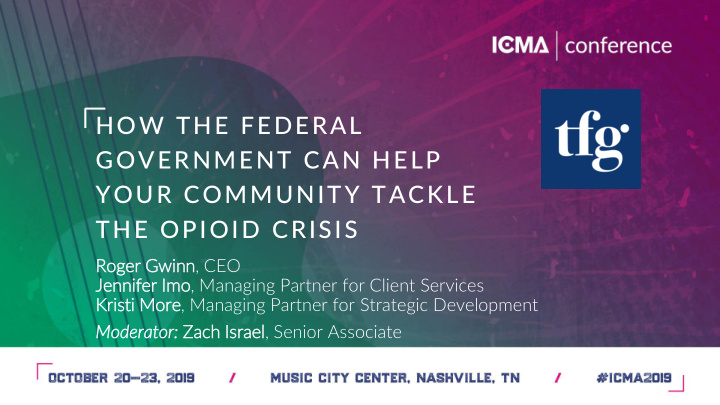



HOW THE FEDERAL GOVERNMENT CAN HELP YOUR COMMUNITY TACKLE THE OPIOID CRISIS Ro Roger Gwinn, CEO Je Jennifer Im Imo, Managing Partner for Client Services Kris risti More, Managing Partner for Strategic Development Moder erat ator: or: Zach Isr Israel, Senior Associate
INTRODUCTION Over the past three years, three major bipartisan pieces of legislation were passed by Congress and signed into law to confront and address the nation ’ s widespread over-prescribing and abuse of opioids: Comprehensiv ive Addic ictio ion and Re Recovery Act t of of 2016 (P.L. 114-198) — signed into law • on July 22, 2016 st Century Cures Act (P.L. 114-255) — signed into law on December 13, 2016 21 st 21 • SU SUPPORT for for Pati tients and Com ommuniti ties Act (P.L. 115-271) — signed into law on • October 24, 2018 How has this legislation, with numerous provisions involving law enforcement, public health, stricter oversight of opioid production and distribution, and healthcare financing and coverage, benefited local governments? What additional steps and policy changes can the federal government adopt to address the opioid epidemic and better assist local stakeholders?
Comprehensive Addiction and Recovery Act of 2016 Passed the House by a vote of 407-5; passed the Senate by a vote of 92- • 2. The law authorizes over $181 million annually for fiscal years 2017 — • 2021 in new funding to fight the opioid epidemic. The largest new grant program for local governments is the • Co Comprehensive Opio ioid Abuse Gran rant Pro rogram ($103 million annually), run by the U.S. Department of Justice (DOJ). The program codifies a grant program at the Substance Abuse and Mental Health Services Administration (SAMHSA) to expand access to life-saving opioid overdose reversal drugs by supporting the purchase and distribution of opioid overdose reversal drugs and training for first responders and other key community sectors.
21 st Century Cures Act Passed the House by a vote of 392-26; passed the Senate by a vote of 94-5. • The law creates a new opioid grant program, authorized at $500 million annually • for FYs 2017 and 2018, for States to respond to the opioid abuse crisis. Run by the U.S. Department of Health and Human Services (HHS), this grant • program supports state responses to opioid abuse. Specifically, the provision authorizes appropriations to support two categories of grants to states: grants “ for the purpose of addressing the opioid abuse crisis ” ; and ▪ grants for activities that supplement opioid-related activities undertaken by the state ▪ agency that administers the substance abuse block grant.
SUPPORT for Patients and Communities Act Passed the House by a vote of 396-14; passed the Senate by a vote of • 99-1. The law includes numerous grant programs for FYs 2019 — 2023: • Reauthorization of the Comprehensive Opioid Abuse Grant Program at $330 • million annually; Reauthorization of the State Response to the Opioid Abuse Crisis grants at • $500 million annually; Authorization for the Pilot Program for Public Health Laboratories to Detect • Fentanyl and Other Synthetic Opioids at $15 million annually; and Authorization for the Comprehensive Opioid Recovery Centers grant program • at $10 million annually.
Additional steps and policy changes the federal government could adopt to address the opioid epidemic and better assist local stakeholders Despite reauthorizing and creating several new grant programs, the total • new spending from the three recent opioid-related laws still falls short of the tens of billions of dollars that experts say is needed to quickly reverse the opioid epidemic. Congress could go much bolder: In February 2018, the New York Times • asked 30 experts how they would spend $100 billion over five years to address the opioid epidemic — a number comparable to how much the U.S. spends domestically on HIV/AIDS. The consensus of the experts was that any effective strategy should include funding for four major areas: treatment (47% of spending), harm reduction (15% of spending), and both demand (27% of spending) and supply-focused (11% of spending) solutions.
What local governments can do to better advocate for support to combat the opioid epidemic Annual Appropriations : lobby your Congressional • delegation to ensure that currently authorized opioid- related grants programs are fully funded each fiscal year. Policy Changes : advocate for policies that would benefit • your local community. This can be directly with your Congressional delegation or through relevant national organizations. Apply for Grant Funding : utilize existing streams of federal • money to benefit your local community by applying for competitive grant funding.
THANK YOU Questions? Roger Gwin Rog inn: rgwinn@tfgnet.com Jenni Je nnife fer Im Imo: jimo@tfgnet.com Krist risti Mor ore: kmore@tfgnet.com Zach ach Is Isra rael: zisrael@tfgnet.com 202-331-8500 www.thefergusongroup.com
Recommend
More recommend